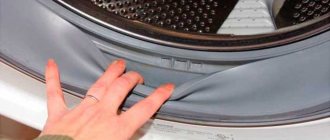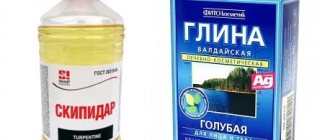Automatic washing machines have greatly simplified the difficult procedure of removing dirt and stains from clothes. However, this miracle of technology can also bring surprises. It happens that laundry smells bad after washing, despite using detergents with a pleasant aroma.
There are two scenarios when all things at once or just one item smell unpleasant. In the first case, the reason lies in the machine and the choice of powder for washing the item. If there is only one item emitting aroma, then you will have to deal with it separately and, possibly, use a different cleaning process. It is worth considering the possible reasons in order to determine exactly why things smell bad after washing.
Causes of musty odor
First of all, it’s worth finding out whether this smell occurs constantly or whether it comes from one specific thing. One item of clothing should be dealt with separately. It may be worth replacing the item's cleaning system itself. If mustiness is felt systematically, you should pay attention to the following reasons:
- too much detergent or poor quality powders;
- Remains of standing water cause mold and bacterial growth;
- using the machine to store dirty laundry;
- lack of proper care of equipment;
- problems with individual elements of the washing machine (for example, an incorrectly connected hose).
Don't ignore the musty smell, as it won't go away on its own. And you shouldn’t mask it using all kinds of conditioners and balms.
Why do things stink after washing the machine?
The cause of the stench emanating from laundry washed in a machine can be:
- stagnation of water in the washing machine tank;
- clogged hoses, filters or unit pipes;
- improper installation of the machine;
- contamination in the detergent dispenser;
- mold or fungal formations in the machine components;
- improper use of laundry detergents, their insufficient quality;
- damage to the heating element;
- constant operation of the unit in conditions of high humidity and in the absence of proper ventilation.
If clothes smell bad after machine washing, you need to find the exact cause and eliminate it - this will not only help solve the problem of stench, but also extend the life of the unit.
Where does the rotten and sour smell come from?
Things smell rotten and sour after washing if they have been in the water for too long. This may involve prolonged soaking during the hand washing process. And also if it was soaked in for too long during the washing cycle. This may occur during an unplanned power outage. Also, the smell of dampness can occur if small elements of things remain in the unit. Such as threads, small pieces of matter.
The process of rotting occurs, the growth of bacteria accelerates, and things get an unpleasant sour smell. The same effect can be caused by excess insoluble powder, which forms a muddy consistency favorable to microbes.
One thing problem
To eliminate the unpleasant smell of dampness from terry products, you can soak them in a weak solution of vinegar.
Some items smell bad after washing, while the majority of the laundry is fine. This most often happens with terry products. They require a large volume of water for rinsing and a certain regime. It is recommended to wash such items separately, adding a rinse stage and reducing the load on the machine.
It is important to dry terry clothes correctly, ensuring good air flow. If you hang products in the bathroom, they will smell damp. To correct the situation, if the laundry smells damp after washing, rinsing in a solution of table vinegar will help (2 tablespoons per bucket of water at room temperature is enough).
Sewage smell after washing
If your laundry smells bad from the sewer, you should call a specialist. A technical problem has arisen. There may be two reasons:
- The drain hose does not fit correctly. Most often, this problem occurs when purchasing new equipment. In this situation, the drainage does not occur properly, water accumulates in the compartments and causes a bad smell.
- If the car is no longer new, the valve usually fails. Water accumulates inside the machine after draining and begins to rot.
To fix such a problem, you need to properly install or replace equipment parts, so without special knowledge it will be difficult to do this.
We follow the rules
Constantly ignoring generally accepted housekeeping standards will quickly render expensive equipment and good clothes unusable. The smell of black mold ingrains itself into clothing, and often owners even stop noticing it.
This kind of amber can often be found on public transport. Just imagine how unpleasant this will be for others, and how embarrassing it will be for you if someone else points it out... Don’t allow these troubles to happen.
Competent advice from specialists and their strict adherence will bring purity, freshness, fabulous aromas and a great mood into your life.
Rubber smell
Things stink after washing when buying a new machine. If you run your very first wash at a high temperature, the rubber smell may become stronger. Therefore, manufacturers recommend running the first washes without filling with laundry. Over time this smell will go away.
If the smell suddenly appears in an old car, you should pay attention to the cuff (rubber rim). It may be too tight, coming out of the frame and rubbing against the drum. In this case, you need to trim off the excess rubber part.
Source of the stench
Almost all new equipment smells like plastic when turned on, and washing machines are no exception. Most often this is considered the norm. In the first days of operation, the rotation mechanisms are ground in, especially their rubber elements. Grinding in is accompanied by a slight hum and a foreign odor. Over time, the components “get used to” and the release of odorous vapors stops.
The main thing is to immediately eliminate the burning smell. Sometimes the cause of an unpleasant “aroma” is damaged insulation, a heating extension cord, or an outlet. In this case, you cannot hesitate - you need to turn off the power to the equipment and check the electrical network. Grinding in of mechanisms and wiring are not the only causes of “smell”. The machine can also emit plastic fumes due to the drive belt, tank, cuff, engine, low-quality components and powder.
- Tank and cuff. During the first washes, plastic polymer tanks heat up, releasing plasticizers and chemical additives - this is inevitable.
- Drive belt. A loose or poorly tensioned rubber band on the drive heats up when the pulleys rotate and emits a characteristic odor. Here you should intervene: replace or fix the “rim” correctly.
- Poor quality components. Cheap plastic emits vapors when heated, and the worse the build quality, the longer the “amber” will last.
- Washing powder. Poor-quality detergent is not an obvious factor why the washing machine smells. Try changing the cleaner first.
- Engine. We are talking about unpolished electric brushes, the carbon tips of which initially rub off on the motor housing. Or about a leaking tank.
It’s better to try to find out why the washing machine smells like burning or plastic. At least exclude dangerous options with overheating wiring, leaks and drive belts. We will describe the step-by-step action plan below.
The appearance of a persistent unpleasant odor
Sometimes things smell damp after washing and it’s difficult to find the reasons. The washing machine is technically correct, the powder is of high quality and the dosage is observed. Why doesn't the persistent smell go away?
It is worth paying attention to the laundry itself. Many housewives, due to lack of space, sin by storing dirty laundry inside the car. Since the environment there is always damp and damp, and the linen is not clean, a persistent sour odor is formed. This reason cannot be immediately detected, and the smell itself may be weak and noticeable only to others. Therefore, you need to maintain hygiene and store your laundry in a basket.
Proper drying
Wash towels when dirty. Even if they look clean, after several times of use it will become noticeable that particles of gels, shampoos, dirt and sebum settle on them, which are a favorable environment for bacteria. Therefore, wash your clothes at least once a week.
To extend the life of bath and kitchen towels and spend as little effort as possible on removing unpleasant odors from them, try to dry your laundry correctly:
- Do not store damp used towels. Wash them immediately, and if it is not possible to do this, dry them well, otherwise not only the bath accessories, but also all the things in the laundry basket will smell unpleasant later.
- Do not dry towels in the bathroom. The best place for drying clothes is the street or balcony - after them the laundry will be provided with a pleasant aroma. During the cold season, dry items on a heated towel rail in one layer.
Washed towels must be dried during the day, otherwise a musty smell is inevitable - this is especially important for thick bath accessories
Smell of chemicals
A strong chemical smell occurs when too much fabric conditioner and conditioner is used. On the one hand, many people want to achieve a pleasant aroma from their washed clothes. On the other hand, they contain too many chemicals, which are what the laundry acquires after washing. In addition, it is very harmful to health. These substances must be used carefully.
The second reason for this smell may be the composition of the fabric of the new clothes purchased. It may also contain chemicals. Over time it will pass.
Regarding bathroom accessories
Everyone knows that the bathroom is a room with high humidity. Therefore, bathroom accessories, in particular bathrobes, towels and rugs, are saturated with moisture and retain its persistent odor.
These household items require special attention:
Fuzzy items or terry fabrics need to be dried well in the open air rather than left on a hanger in the shower;
- Before traditional washing, pre-soak such items in a cool vinegar solution and set the additional rinse mode;
- It is recommended to wash such items separately from the rest, and replace the conditioner with vinegar.
For order – prevention is important!
To avoid taking the situation to extremes, follow the basic rules for using the washing machine:
- After each wash cycle, wipe the rubber fittings and loading compartments with a dry cloth;
- If possible, keep the drum door ajar;
- Do not leave clothes for a long time after washing and do not store contaminated items, but load them immediately before washing;
- Use household chemicals in accordance with the manufacturers' instructions indicated on the packaging of such products;
- For preventive purposes, turn on water hardness softeners, which can clog holes and hoses, where deposits form and pockets of pathogens appear;
- Do not mask the problem with intensive use of air conditioners;
- Periodically clean the inside of the washing machine and run the machine idle once every 2 months;
- Organize appropriate conditions for fresh air circulation in the room where such equipment is installed.
RESULT
As practice shows, unpleasant odors on clothes can appear due to a difficult situation inside the washing machine.
Moreover, these troubles most often arise from improper operation of household appliances or irrational use of chemicals.
Having eradicated the problem and solved the issue of the unbearable aroma once, do not forget in the future about prevention when working with the washing machine.
Eliminating the causes of odor
After identifying the cause, it is necessary to take a number of measures to eliminate it:
- check the drainage filter at the bottom of the machine and clear it of debris;
- remove and wash the detergent compartments;
- check the sewerage and the correct connection of the hose;
- run a preventative wash with the addition of citric acid;
- clean the hatch cuff
- Monitor the cleanliness of equipment at all times.
It is also worth keeping track of the time that the laundry remains in the washing machine before washing and the time the laundry is already clean and damp.
Causes of bad aroma
Removing the smell of dampness from clothes is not so easy. After all, the main reason for this phenomenon lies in high humidity. In the autumn and winter seasons, it is not possible to fully ventilate the apartment and dry products on the balcony under the sun's rays.
Experts also identify another, no less common reason. It lies in improper drying.
How to get rid of the musty smell of clothes? To solve the problem, first thoroughly dry the products in the sun. If it’s winter outside, this will not interfere with removing the stench. Hang all your summer clothes and outerwear on the balcony. In many cases, this measure is quite sufficient.
If the aroma is distinguished by its persistence, then you will have to resort to more radical methods. For such cases, special cleaners, deodorants for products and traditional methods will come to the rescue.
At home you can use:
- 9 percent vinegar;
- baking soda;
- brown;
- turpentine;
- ammonia;
- oxygen bleach;
- coffee beans;
- lemon juice or acid.
Odor can appear on any type of fabric. Depending on this, the desired method is selected. How to remove stench from wool and silk fabrics?
There are several effective remedies.
First method
To eliminate musty smells, use turpentine. Soak a cotton pad in the liquid and treat all damaged areas of clothing.
As a supplement, you can use white clay. Sprinkle it onto the areas to be treated. And then iron it through a layer of parchment paper with a hot iron. After this, wash with laundry soap and dry.
Second method
To complete the procedure, wash the wool or silk item in the washing machine with the addition of washing powder. Do not forget that such fabrics can only be washed on a delicate cycle.
Third method
A time-tested product in the form of baking soda will remove the stench. Add a spoonful of sodium bicarbonate to the powder tray and wash at 40 degrees.
They are as follows:
- Use table salt. To prepare the product, take a liter of warm water and mix with two tablespoons of salt. Also add a spoonful of ammonia solution. Place the mixture on the stove and boil for 30 minutes. The finished product is applied to clothing and left for an hour. After the time has passed, the items are washed as usual and dried in the fresh air.
- Use onions. Take a small onion and cut it in half. Scrub the moldy area. If you need to get rid of the musty smell, grate the vegetable and squeeze out the juice using gauze. Mix with a liter of water and soak for 15 minutes. Then wash with powder. Add conditioner at the end of the wash.
- Yogurt can also be useful on the farm. The product is very easy to use. Just soak the items and leave for 10 hours. It is better to carry out all manipulations at night. And in the morning, wash your clothes in the washing machine.
The advantage of such tools is that they are always at hand.
Even the cleanest housewives can develop an unpleasant smell after washing in a machine. To get rid of this problem, it is necessary to find out the cause of the unpleasant phenomenon.
- The washing machine has not been cleaned for a long time from residues: lint, powder, bacteria.
- The machine is left closed.
- They put the laundry in the drum and keep it until washed again, then it acquires a musty smell that is difficult to get rid of.
- Soaked laundry remains in the powder for a long time.
- Laundry is dried in the bathroom, not in the fresh air.
- An item with a nasty smell got into the wash, ruining the aroma of all products.
- They put in a powder or conditioner with an unpleasant aroma.
- Incorrectly connected drain, water smells like sewer.
- A lot of detergents are provided.
Odor removal products
If a bad odor comes from mustiness or mold, it will be difficult to get rid of it by simply airing it out. It is necessary to eliminate the most important problem - to get rid of bacteria and their further reproduction. For this purpose additional means are used.
Vinegar
When using this product, pour a weak solution of vinegar into the compartment, not powder. To do this, start the wash as usual. In the middle of the wash, stop the machine for a break of about 20 minutes. Then continue washing the laundry and also add a vinegar solution when rinsing. Afterwards, the laundry must be well ventilated and dried. Vinegar can also remove the bad smell of laundry and clean the washing machine from mold.
Soda
Baking soda is also an excellent odor absorber. It is added to the washing machine instead of powder and an accelerated wash is started. Just like with vinegar, soak it. Clean linen is placed in a closet, which is also pre-treated with a solution of water and soda. Thus, it is possible to completely get rid of pathogenic bacteria. Baking soda is the most inexpensive, but very effective method of getting rid of odor.
Iodine
Clothes that have acquired the smell of mold take it with them to the closet shelves. To remove it not only from linen, but not to spread it to other things. You can use a bottle of iodine. It perfectly replaces flavor sachets. You just need to use it carefully. Place it in a deep bowl, using cotton wool instead of a cork, through which the substance will enter the air. Iodine vapor will kill any fungus and prevent its reappearance.
Flavors
Both artificial and natural sachets can be used as flavorings. Coffee will be a good filler; it will give the laundry a pleasant aroma. Instead of coffee, you can use regular soap. It can be used as a block or as shavings in a bag. It needs to be changed periodically. You can make fragrant sachets yourself by drying pleasantly smelling herbs (mint, lemon balm, lavender) or citrus peels.
Vodka or alcohol
Cotton underwear, such as linen or cotton, can be very well refreshed with alcohol products. You can rinse your laundry in a diluted alcohol solution. Or you can make a spray with half a glass of distilled water and half a glass of inexpensive vodka. You can also add various oils, such as lavender. The admixture with oils gives a delicious aroma and promotes good sleep when treating bed linen.
Sodium borate
A good way to get rid of damp smell is to use sodium borate. With it, the solution is diluted in a basin, clothes are soaked there and left for four hours. Next, you need to rinse and put it in the washing machine again so that not a trace of the product remains on the clothes.
Ammonia
When using ammonia, bad-smelling laundry is washed twice. Once with ammonia and then again as usual. Ammonia is a very strong agent that can kill any amber. The only drawback of ammonia is that it is necessary to carry out the entire procedure in a room with a good draft. Excess ammonia vapor can have a bad effect on the human body.
Hydrogen peroxide
To use this method, 100 milliliters of peroxide are diluted per liter of water. I soak the laundry in this solution, but not more than 10 minutes. If the fabrics are natural, it is possible to use an undiluted solution. Hydrogen peroxide perfectly fights against strong and old odors, and also gets rid of amber of organic origin (sweat, fungus, dampness).
Salt
Two to three tablespoons should be thoroughly dissolved in a liter of water. Next, soak for half an hour and rinse well, ventilate and dry. Or wet clothes are generously rubbed with salt. Leave it in this position for a while, then wash and dry again.
Cleaning the washing machine, what needs to be cleaned
Each wash should be carried out in a clean and dry drum.
Be sure to read:
How to get rid of smell in a clothes closet: effective methods of combating mustiness
Proper care involves:
- drying the rim between the drum and the door,
- wiping the inside of the machine with a dry cloth,
- timely cleaning from deposits and accumulations of detergents,
The water filter also eliminates partial penetration of bacteria.
It is recommended to clean it once a month using a mild detergent. Rubber elements can be cleaned with baking soda dissolved in water (200 ml per 1 tbsp). After this, vinegar is used for wiping.
Another way is to start a dry wash (without laundry). The temperature should be set in the range of 90-95 degrees. Citric acid (100 g each) is added to the compartment for powder and other laundry detergents.
Lemon allows you to eliminate not only bacteria, but also the resulting scale.
When cleaning the unit, in the middle of the running cycle, you need to turn off the machine. This will allow for deep cleaning of contaminants. Then you need to turn on the “Rinse” mode, this will remove citric acid.
Cleaning using a similar algorithm is carried out using soda or chlorine (bleach).
In some cases, it is necessary to replace the drain and other hoses suitable for the unit, and additionally thoroughly clean the inside of the machine. In this case, you will need to disconnect the hoses, replace the filter, and clean the heating system elements.
Necessary preventive measures
Following a few tips will help prevent unpleasant odors:
- You need to wipe the washing machine with a napkin and clean the ditch.
- Always leave the car door open.
- Clean filters and valves once every couple of months.
- Wash more often at high temperatures
- Keep dirty laundry in a special basket.
- Do not overload the unit with laundry.
- Do not exceed the dosage of cleaning agent.
- Use softening agents.
- Hang out your laundry immediately and do not leave it wet.
- Use high-quality detergents that are not expired.
Timely preventive measures will prevent the presence of an unpleasant odor. The most reliable way is to wash in clean water and dry in fresh air. Thanks to these simple methods, your laundry will always be clean and smelling good.
Clean the machine
Start by cleaning your washing machine. Mix water and vinegar in a 1:1 ratio, pour the mixture into the bleach compartment and run the wash cycle.
Alternatively, you can use regular bleach. If you have a machine self-cleaning mode, then run this program.
Do not mix bleach with vinegar. This composition is too aggressive. Use only one of the cleansers.
After finishing washing, wipe the gaskets near the door with a sponge or soft cloth to remove mold.
Ways to solve the problem
A problem such as a putrid odor will not return if you follow the basic rules for operating a washing machine, which many people forget:
- After each cycle, accessible parts of the device should be wiped with a soft cloth until dry. This applies not only to the drum, but also to the trays and the sealing ring around the hatch opening. Keep the drum slightly open if possible.
- We do not store dirty clothes in the bin, even if there is very little time left before washing. We load the drum immediately before supplying water.
- We use washing powders and gels strictly for their intended purpose, observing the dosage and temperature conditions. You should not actively use air conditioners if your laundry smells unpleasant; this will only temporarily mask the problem, leading to more serious consequences in the future.
- We regularly carry out preventative cleaning of the car, using approaches with vinegar or citric acid.
- At least once every two months we run the unit through a full wash cycle at the highest possible temperature. At the same time, we do not load the drum.
- We do not keep washed items in the machine longer than necessary; immediately after the end of the cycle we begin drying them.
In addition, experts do not recommend installing specialized household appliances in a bathroom or other dark room without good air circulation. A dry and regularly ventilated kitchen is more suitable for the appliance.
Once the cause of the unwanted odors has been determined, you can begin to eliminate it. The first thing you need to do is clean the washing machine.
- First you need to thoroughly clean the rubber seal. You need to remove moisture and mucous deposits from it with a dry cloth. Then rinse and treat with a cleaning agent, such as liquid laundry detergent or dishwashing gel. Rinse with water.
- In order to destroy harmful microorganisms and heavy dirt from the surface of the drum, you need to treat it with a solution of water and baking soda (2 tablespoons per 400 ml of water), then wipe with food vinegar. You can do the same with the powder container and the rubber cuff.
- Then you should run the car idle at the highest possible temperature. This will help destroy bacteria and molds that survived after the initial treatment. You need to pour 100 g of baking soda, bleach containing chlorine, or citric acid into the washing powder compartment. The latter will also help deal with scale. After about half of the program has passed, turn off the washing machine for a while - this will allow you to more thoroughly disinfect it from the inside. After a pause, restart the program until the wash cycle is completed. To ensure that all cleaning agents have been removed from the drum, you can additionally run a rinse program.
- Rinse the detergent container. Since mold can also appear in it, when the powder is washed out during washing, it gets into the laundry. To clean, you need to remove it from the machine and soak it for 3-4 hours in a chlorine-containing solution. Then wipe with a sponge, wipe dry and return to its place. For more thorough cleaning, go through hard-to-reach areas with a toothbrush.
Apply the described cleaning method 4-6 times a year, depending on the intensity of use of the household appliance.
What to do if your clothes start to smell bad?
When a faint, unpleasant odor emanates from washed items, it will be enough to hang the laundry in the fresh air.
It’s good if the day turns out to be windy and sunny. In this case, the laundry will quickly acquire the aroma of freshness. But you can’t dry it indoors - this will not help get rid of the stench, but on the contrary, it will strengthen it.
In case of a strong and persistent smell of rottenness (mold) from things, it is necessary to resort to rinsing in water with the addition of a scented rinse aid. After which prolonged drying in the fresh air is necessary.
Folk recipes
Sometimes rinsing and airing washed clothes is not enough to restore their freshness. Then it is recommended to use some effective folk remedies, which are presented in the table:
| Ingredients | Preparation | Application |
| Borax | Take 1.5 liters of warm water and dissolve 50 g of powder in it. | Soak the items in the resulting solution and place cling film on top of the container. Leave the items for 4 hours, then rinse and wash with regular powder. Dry outdoors. |
| Soda | It does not need to be dissolved in water and takes approximately 100 g. | Load smelly things into the drum. Washing powder is poured into one compartment, soda (about 100 g) into the other. Turn on the standard washing mode and at the end start rinsing 2-3 times. Then they dry the clothes in the fresh air. |
| Table vinegar (9%) | Dilute 170 ml of vinegar in 2.5 liters of water. Mix water with water in equal quantities. | Immerse the items in the solution for 1 hour and wash as usual. Pour liquid into the conditioner compartment and wash on a standard cycle. |
| Vodka | Used in its pure form. The ratio with water is 1:1. | Pour into a spray bottle and treat the foul-smelling item. It is advisable to carry out such manipulations on the street or balcony, hanging the products on a rope. |
| Alcohol | Combine alcohol and water in a 1:1 ratio. | |
| Ammonia | Dilute ammonia with water to obtain a slightly concentrated solution. | Things are sprayed with this product. The method is suitable for outerwear and hats. |
Chemicals
You can rehabilitate items after unsuccessful washing using special chemicals that effectively cope with unpleasant odors.
Thus, the Dr. Beckmann company produces various products for the care of things and fabrics, as well as household appliances. Their range of products includes some pretty effective odor eliminators.
Thanks to their unique formula, it is possible to destroy pathogenic bacteria from deep in the fibers. These products are used according to the instructions: added to washing powder or poured in instead of rinse aid.
Another option is Denkmit Hygienespüler. The product is suitable for all types of fabric. It is hypoallergenic, so it is recommended for use when washing even children's underwear. As a result, it helps to destroy fungi and bacteria in tissues by almost 100%, giving products freshness.
If 1 specific product stinks
Often, after washing, not all laundry smells, but individual items (for example, a terry towel or bathrobe). The washing machine is clearly not to blame here.
This phenomenon is usually observed due to an incorrectly selected detergent or washing mode. Therefore, you must first study the manufacturer’s recommendations on the product label.
Another reason for an item to smell bad is drying it in a closed room without good ventilation. As a result, the product does not dry completely, which leads to the formation of mold.
Therefore, it is better to dry terry products on a ventilated balcony or outside in the summer, and in winter - on a radiator or electric heated towel rail.
You can restore such a wonderful aroma by rinsing in a vinegar solution and drying it again in the fresh air.
Why is there a stench?
Before you start fighting unpleasant odors, you need to study the reasons for their appearance:
- Using large amounts of laundry detergent. Many housewives believe that if, when washing clothes, they add detergent in a larger volume than indicated in the instructions, it will only be better, but this is not so. When using a large amount of detergents, all residues not used during the washing process will begin to settle on the working elements in the form of plaque. It is he who will subsequently begin to emit unpleasant odors.
- Sewer system. Household appliances for washing clothes may not always be the source of the stench. The poor condition of the sewer system can affect the operation of the machine - automatic. This is easy to check: you just need to compare the smell in the appliance with the aroma emanating from the sink pipes. If they are identical, then the problem comes from the sewer pipes.
- Scale. Water contains large amounts of salt and magnesium. Most often, this leads to scale forming on the heating element of the washing machine. Its appearance is also influenced by a large accumulation of dirt and detergents. Because of this, the performance of the machine decreases and energy consumption increases. If you do not deal with scale, the equipment will soon be unsuitable for use.
- Poor condition of the hose. A washing machine cannot run forever. To extend the service life of the washing unit, it is necessary to carefully monitor its components. After a couple of years of use, the hose in the machine may wear out. Over time, dirt accumulates on it, reducing performance. Small deposits can be cleaned by running the washing machine without laundry. But this method will not help cope with strong and stagnant pollution. In such a situation, only purchasing and installing a new hose will help.
- Dirt in the tray. Contamination of this element of the washing machine is a common cause of mold. Washing the tray regularly will reduce the amount of dirt and prevent the appearance of musty odors. If you failed to monitor the condition of the tray in time and mold has already formed on it, just rinse it under running water. When these manipulations still do not allow you to get rid of unpleasant odors, you should carefully check the washing machine for malfunctions, as well as for the presence of mold in other places.
- Dirt in the drain filter. A filter helps protect sewer pipes from dirt, detergents, and clothing items getting into them. Once every 5-7 months you definitely need to change it to a new one. Otherwise, the smooth operation of the machine may be disrupted. Water stagnation will begin to appear, and unpleasant odors will intensify.
- Dirt in the supply channel. If the owner has not looked after the tray well, there is a high probability of contamination developing in the channel. Conditioners and powders are not always completely washed off from the tray to the laundry; a certain amount remains on the walls, growing moldy over time. If you remove the tray from the machine, you can clean the channel from moldy stagnation and dirt manually, using a regular toothbrush or a bottle brush.
- Using low-quality detergents. Many housewives love to experiment. Using just one powder or conditioner sometimes gets boring. I want to try something new: a new flavor, new granules, new possibilities. But such innovations do not always benefit the washing machine, especially in cases where the new product turns out to be of poor quality. A product that should not be used for washing clothes can be easily identified by the formation of plaque. If, after changing the detergent, odors appear in the drum, it is advisable to return to the proven detergent. Otherwise, the smell will only get worse.
- Wash at low temperatures. Not every garment can be washed at temperatures above 60⁰. But, when washing in cool water, detergents do not dissolve well. As a result, they settle on the internal parts of the machine, gradually leading to the formation of a fungal coating. To reduce the likelihood of mildew, you can use chlorine bleach. They help to corrode the mucus formed during washing and wash away plaque from the rubber cuffs.
Using too little or too much detergent
In fact, knowing how much detergent to use is quite simple, since the packaging contains all the required information regarding how much to put in and how to use it correctly. The amount largely depends on how much laundry you wash.
It is also important to consider how hard the water is. If the water has a high lime content, then it is considered hard and therefore you need to use a little more detergent
Unpleasant odors may appear if only liquid detergents are used when washing. Unlike powder or capsules, they do not contain bleach, which helps kill germs. The disadvantage of bleaching agents is that they can only be used on light-colored clothing.
If using the required amount of powder or detergent does not give any result, then you can try hygiene products. They contain disinfectants that help eliminate germs from the washing machine that cause an unpleasant odor. However, it is not recommended to use it every time you wash.
Women's jeans: before you buy them, you need to pay attention to one detail
Smooth and fresh skin: dermaplaning, or why a woman needs to shave her face
A student at the Vietnam Police Academy shared how she takes care of her facial skin.











